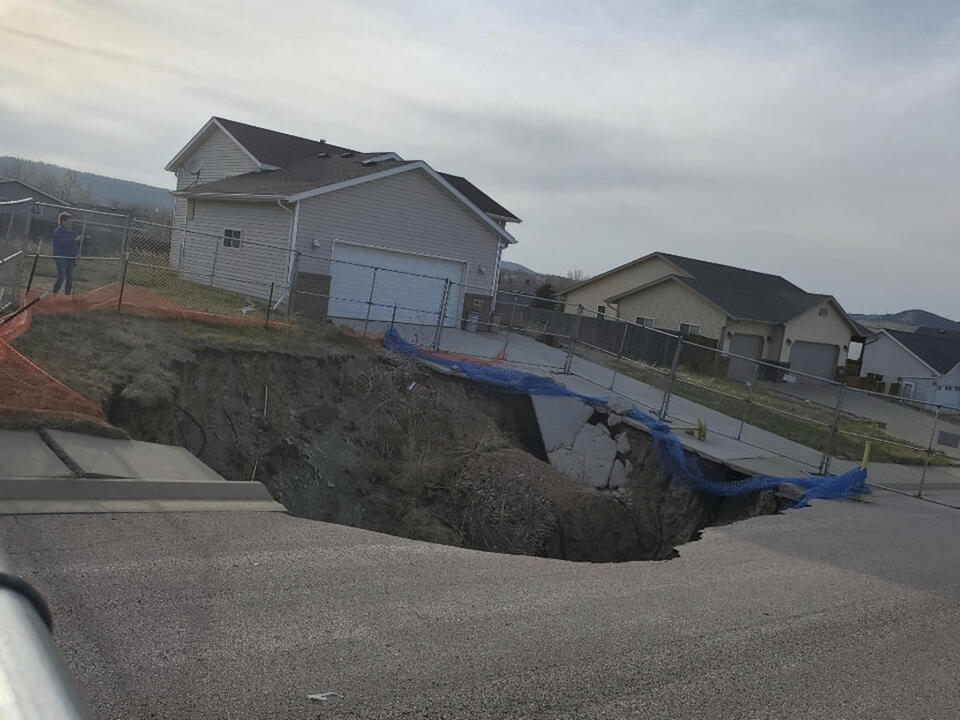Physical Address
304 North Cardinal St.
Dorchester Center, MA 02124
Physical Address
304 North Cardinal St.
Dorchester Center, MA 02124

Stuart and Tonya Junker cherished their peaceful neighborhood near South Dakota’s Black Hills. However, their idyllic lifestyle took a drastic turn when sinkholes began to form, raising fears about the safety of their home and the stability of the ground beneath them.
The Junkers, alongside approximately 150 other residents, have taken legal action against the state, seeking $45 million to cover the loss of their homes and related expenses. They argue that the state sold land for the Hideaway Hills subdivision while being aware it was situated above a former mining area.
Tonya Junker expressed the profound impact this crisis has had on their lives. “Let’s just say it’s really changed our lives a lot,” she stated. “The worry, the not sleeping, the ‘what if’ something happens. It’s all of it, all of the above.”
Sinkholes are not uncommon and can form due to natural geological processes, such as the collapse of caves or old mines. However, the situation in South Dakota stands out due to the potential danger posed to numerous homes in the Hideaway Hills area. Paul Santi, a geological engineering professor at the Colorado School of Mines, believes that this case will likely be studied in future geological discussions. “I can say just from having taught classes about case histories with geologic problems that this would be a case that will end up in textbooks,” Santi remarked.
The development of Hideaway Hills occurred between 2002 and 2004 in an area previously owned by the state where gypsum was mined for a nearby state-owned cement plant. Attorney Kathy Barrow represents residents living in 94 homes in the subdivision. She asserts that while the state sold the surface rights to the land, it failed to disclose the removal of soil that originally helped support the surface.
Initially, residents noticed minor sinkage over time, but the situation escalated significantly in 2020 when a sizable sinkhole opened up as a man mowed his lawn. This incident prompted residents to contact Barrow for assistance. Investigations revealed a poorly sealed mine located beneath the northeastern section of the subdivision, as well as a substantial pit mine lurking in another corner.
Since the first significant collapse, the number of sinkholes has proliferated, with Barrow stating that there are “too many to count.” These geological instabilities have destabilized not only 158 homes but also roads and utility systems.
In one poignant example, an old truck can be seen in a hole underneath a home’s porch, a remnant from when a previous landowner pushed it into a mine cavern during the 1940s. Although the area surrounding the 2020 sinkhole has been vacated and barricaded, many residents remain in their homes due to financial constraints.
“They’re worried about school buses falling into a hole. They worry about their houses collapsing on their children in their beds at night,” Barrow explained. “I mean, you spend your whole life putting money and building equity in your home. It’s your most prized asset, and these people’s asset had become not only worthless but almost a negative because they’re dangerous to live in.”
While the state’s attorney refrained from commenting on the case, state representatives have requested a dismissal. In official documents, the entities being sued conveyed their sympathies to the property owners and labeled the emergence of sinkholes as “tragic.”
Nonetheless, the state insists that it bears no responsibility for the events that have unfolded. “Those truly liable in this case are the developer, the initial realtor, and the numerous homebuilders who knowingly chose to build over an abandoned mine while purposefully hiding its existence from the homebuyers purchasing in Hideaway Hills,” the state claimed.
The state’s court documents reveal a rich mining history dating back to the 1900s, with surface and underground mining activities carried out until around 1930. The state argues it cannot be held accountable for damages linked to the underground mine collapse and maintains that the situation would have transpired independently of the activities conducted by the cement plant.
For the Junkers, pursuing legal action appears to be their best chance of escaping their current predicament. Tonya Junker lamented that her husband, who was set to retire this year, now faces the burden of working additional jobs to save for a potential evacuation. “That’s a hard pill to swallow,” she said.
Having lived together for 15 years in a home from 1929, initially one of the first structures in the subdivision, the Junkers had envisioned a peaceful retirement. They remodeled their home and looked forward to settling in. “It’s just kind of disappointing that the state won’t take care of us,” Stuart Junker said. “I mean, this is their problem.”
Source: Associated Press



